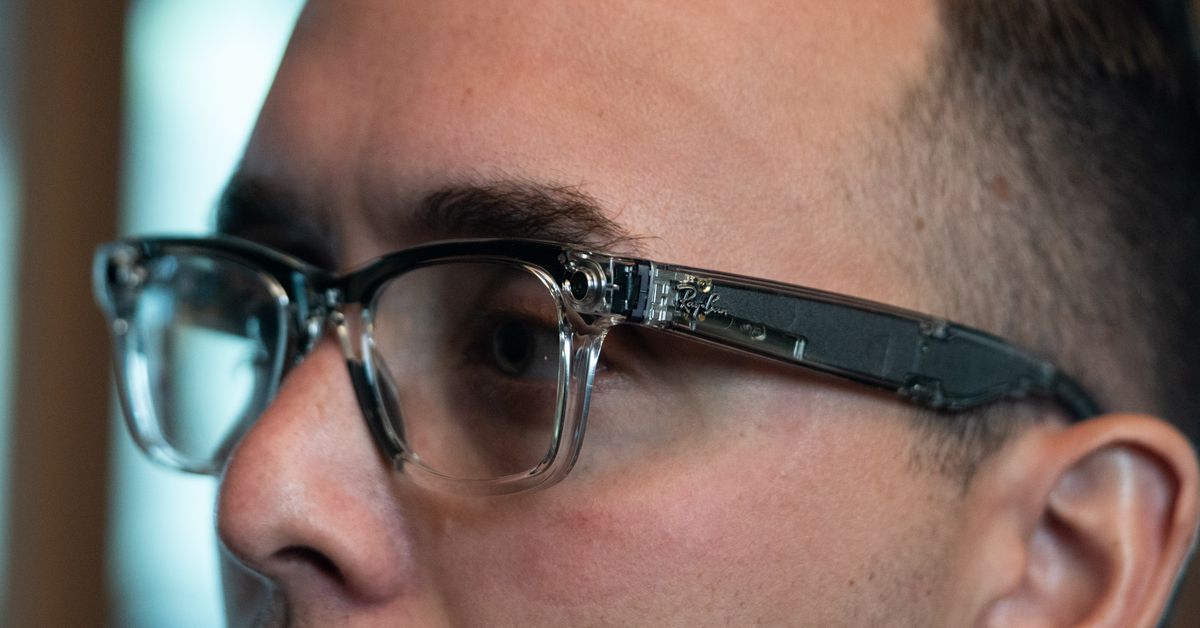All around Meta’s Menlo Park campus, cameras stared at me. I’m not talking about security cameras or my fellow reporters’ DSLRs. I’m not even talking about smartphones. I mean Ray-Ban and Meta’s smart glasses, which Meta hopes we’ll all — one day, in some form — wear.
I visited Meta for this year’s Connect conference, where just about every hardware product involved cameras. They’re on the Ray-Ban Meta smart glasses that got a software update, the new Quest 3S virtual reality headset, and Meta’s prototype Orion AR glasses. Orion is what Meta calls a “time machine”: a functioning example of what full-fledged AR could look like, years before it will be consumer-ready.
But on Meta’s campus, at least, the Ray-Bans were already everywhere. It was a different kind of time machine: a glimpse into CEO Mark Zuckerberg’s future world where glasses are the new phones.
I’m conflicted about it.
Meta really wants to put cameras on your face. The glasses, which follow 2021’s Ray-Ban Stories, are apparently making inroads on that front, as Zuckerberg told The Verge sales are going “very well.” They aren’t full-fledged AR glasses since they have no screen to display information, though they’re becoming more powerful with AI features. But they’re perfect for what the whole Meta empire is built on: encouraging people to share their lives online.
The glasses come in a variety of classic Ray-Ban styles, but for now, it’s obvious users aren’t just wearing glasses. As I wandered the campus, I spotted the telltale signs on person after person: two prominent circle cutouts at the edges of their glasses, one for a 12MP ultrawide camera and the other for an indicator light.
This light flashes when a user is taking photos and videos, and it’s generally visible even in sunlight. In theory, that should have put my mind at ease: if the light wasn’t on, I could trust nobody was capturing footage of me tucking into some lunch before my meetings.
But as I talked with people around campus, I was always slightly on edge. I found myself keenly aware of those circles, checking to see if somebody was filming me when I wasn’t paying attention. The mere potential of a recording would distract me from conversations, inserting a low hum of background anxiety.
When I put a pair on for myself, the situation changed
Then, when I put a pair on for myself, the situation suddenly changed. As a potential target of recording, I’d been hesitant, worried I might be photographed or filmed as a byproduct of making polite eye contact. With the glasses on my own face, though, I felt that I should be recording more. There’s something really compelling about the experience of a camera right at the level of your eyes. By just pressing a button on the glasses, I could take a photo or video of anything I was seeing at exactly the angle I was seeing it. No awkward fumble of pulling out my phone and hoping the moment lasted. There might be no better way to share my reality with other people.
Meta’s smart glasses have been around for a few years now, and I’m hardly the first person — or even the first person at The Verge — to be impressed by them. But this was the first time I’d seen these glasses not as early adopter tech, but as a ubiquitous product like a phone or smartwatch. I got a hint of how this seamless recording would work at scale, and the prospect is both exciting and terrifying.
The camera phone was a revolution in its own right, and we’re still grappling with its social effects. Nearly anyone can now document police brutality or capture a fleeting funny moment, but also take creepshots and post them online or (a far lesser offense, to be clear) annoy people at concerts. What will happen when even the minimal friction of pulling a phone out drops away, and billions of people can immediately snap a picture of anything they see?
Personally, I can see how incredibly useful this would be to capture candid photos of my new baby, who is already starting to recognize when a phone is taking a picture of her. But it’s not hard to imagine far more malicious uses. Sure, you might think that we all got used to everyone pointing their phone cameras at everything, but I’m not exactly sure that’s a good thing; I don’t like that there’s a possibility I end up in somebody’s TikTok just because I stepped outside the house. (The rise of sophisticated facial recognition makes the risks even greater.) With ubiquitous glasses-equipped cameras, I feel like there’s an even greater possibility that my face shows up somewhere on the internet without my permission.
There are also clear risks to integrating cameras into what is, for many people, a nonnegotiable vision aid. If you already wear glasses and switch to prescription smart glasses, you’ll either have to carry a low-tech backup or accept that they’ll stay on in some potentially very awkward places, like a public bathroom. The current Ray-Ban Meta glasses are largely sunglasses, so they’re probably not most people’s primary set. But you can get them with clear and transition lenses, and I bet Meta would like to market them more as everyday specs.
Of course, there’s no guarantee most people will buy them. The Ray-Ban Meta glasses are pretty good gadgets now, but I was at Meta’s campus meeting Meta employees to preview Meta hardware for a Meta event. It’s not surprising Meta’s latest hardware was commonplace, and it doesn’t necessarily tell us much about what people outside that world want.
Camera glasses have been just over the horizon for years now. Remember how magical I said taking pictures of what’s right in front of your eyes is? My former colleague Sean O’Kane relayed almost the exact same experience with Snap Spectacles back in 2016.
But Meta is the first company to make a credible play for mainstream acceptance. They’re a lot of fun — and that’s what scares me a little.
Read the full article here














